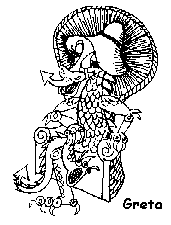YOYO
|
YOYO |
|
|
|
|
Which way does the YoYo go ? Left or right? In both cases? Do you need help? Even if you don't, try moving the mouse over the frabjous, beasties, ZsaZsa, TseTse, and Garbo web versions of the creatures of the Dragon Hunter's Box. But whose suggestions should one listen to, or are they both right or both wrong ? To repeat, The Dragon Hunter's Box is out of print. This site is intended to provide a web version of The Box. Animated versions of various Dragons together with hints and tales of Dragon snaring will be posted here in the coming months. |
|
In sum -- the Dragons in The Box and on this site are accompanied with playful suggestions, sometimes very helpful, sometimes highly misleading, all calculated to direct the would-be Dragon Slayer to the weapons of his/her arsenal. But please note: wooden stakes are NOT suitable -- these are Dragons and Not Vampires! |

|
| The Milko Bottle Problem aka the dragon Milko | |
| The Ilya Revel | |
| Inducia Capillaria I a Lakatosian Monster | |
| Inducia Capillaria II a Mercuric Lakatosian Monster | |
| The Coin Problem | |
| The Flying Omnibus: How and Why Aeroplanes Fly | |
| The BumbleBee Paradox: Why It Can't Fly But Does | |
| The Satellite Paradox: Negative Mass in Low Earth Orbit | |
| Executive Toy -- A Challenge in Metacognition | |
| Cyber -- a 3D Perceptual Dragon | |
| Ayelet's Challenge -- a mathematical puzzle | |
| The Ant on the Box Problem - a new mathematical Dragon | |
| Sir Arthur Eddington's Cricket Puzzle -- For Cricket Fans only |
| The Art of Snaring Dragons |
The author continues to collect Dragons, and the sagas of forays upon those frabjous beasties by physicists, both professional and tyros (=beginners), as well as like beasties in advanced fluid dynamics and stability, tackled expertly by dragon flies and bees, and far less expertly by human aeronautical engineers. I'm contactable as aboutdragonsATtpg.com.au {Replace the AT by @ in your mail program.}

|
There is an interesting correspondence between Dragons and the category of visual illusions -- the Impossible Figures -- that form the basis of Escher's famous lithographs.
The Escher lithographs stimulate. In Waterfall for instance, one traces the flow of water down, down, down, until the water flows into its starting location. Simply impossible. Recently LEGO models based on the Escher Lithographs, Balcony, Belvedere, Waterfall, Ascending and Descending. and Relativity were produced by Andrew Lipson. Photographs taken of these models match the Escher lithographs on which they are based. Yet these are real constructible models of the impossible. Note that the 2007 version of Internet Explorer (unlike earlier versions) does not support Java required to view Lipson's animations. Or are Lipson's models Lakaosian Monsters, a special category of Dragon discussed on these web pages ? |